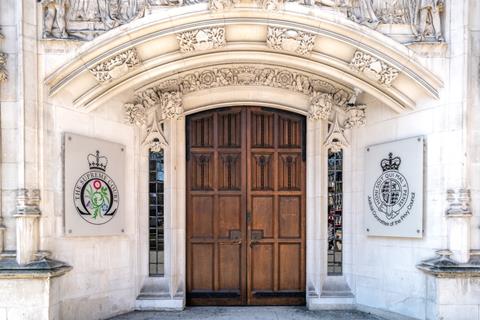Judgement in favour of housebuilding giant over dispute with AECOM-owned engineer will encourage proactive approach to fixing safety defects, say lawyers
Developers have the right to chase their contractors for losses sustained fixing defective buildings, even if they take on remediation voluntarily, the Supreme Court has ruled.
Yesterday, the court handed down its long-awaited judgement in the URS Corporation Ltd v BDW Trading Ltd case, refusing the former’s appeal.

According to legal experts, the verdict has wide ramifications for the built environment sector, providing clarity on numerous ongoing disputes. It will likely encourage developers who have taken a proactive approach to dealing with legacy building safety issues.
The respondent in the case, BDW Trading Ltd, better known as Barratt, engaged AECOM-owned URS, the appellant, as a structural design consultant in connection with a number of high rise developments.
In 2019, during its post-Grenfell investigations into the safety of buildings, Barratt found design defects in two sets of multiple high-rise residential developments on which it had been developer and for which URS had provided structural designs.
In March 2020, Barratt brought a claim of negligence against URS in relation to the defects it had discovered in the developments, which it had already sold, and between 2020 and 2021, performed remedial works to rectify them.
The cost of these remedial works were the basis of its claim against URS. After successive unsuccessful appeals in lower courts in which URS claimed Barratt’s loss was not recoverable, the Supreme Court granted the structural engineer permission to appeal the decision on four grounds.
Yesterday, it found in favour of Barratt on all four grounds.
Underpinning URS’ first ground for appeal was an argument that, because Barratt carried out the repairs voluntarily, in circumstances where it had no proprietary interest or legal obligation to do so, the losses suffered were therefore outside the scope of URS’ duty.
The court rejected this argument, deciding that the four cases on which URS relied for this argument did not establish a ‘voluntariness principle’ according to which repair costs were irrecoverable as a matter of law as being outside the scope of the duty of care or too remote.
While it found that voluntary actions would be relevant to causation and potentially mitigation of loss, it emphasised that responsible developers who act to remedy building safety defects should not be penalised by barring their rights to recovery.
The second ground for appeal asserted that only claims made directly under the Defective Premises Act would be subject to the provision of the –‘∞…µÁî Safety Act, which came into force in June 2022, which retrospectively extended the limitation period for accrued claims from 6 to 30 years.
The Supreme Court instead found that any claim based on the DPA, even if brought in tort or for contribution, would be subject to the extended limitation period
It noted that it was necessary for developers to be able to bring onward claims against ultimately responsible contractors in order to fund their own responsibilities to homeowners, in order not to penalise responsible developers who proactively identify and remedy building safety defects.
The third ground questioned whether URS owed a duty to Barratt to build homes properly under section 1 of the DPA and whether its losses were of a type recoverable for breach of that duty.
The court rejected URS’ position that the DPA distinguishes between those owed a duty and those to whom they are owed, determining that there was no reason why a developer could not both owe and be owed a duty.
The fourth ground asked whether Barratt could make a claim in contribution given that no settlement or judgement had been reached between the developer and the homeowners.
The Supreme Court once again disagreed with URS, finding that it was sufficient that Barratt had made a payment in kind by performing remedial works for homeowners.
Rob Horne, head of construction disputes, Osborne Clarke, which acted on behalf of Barratt, said the judgement gave developers ‚Äúsignificantly more clarity‚Äù over the full effect of the retrospective limitation period introduced by the –‘∞…µÁî Safety Act (BSA).
“Ultimately, the aim of the BSA was to ensure that safety failures are properly addressed and that those responsible bear the costs,” he said.
“This case furthers that aim by ensuring that developers have a clearer path to recover funds from designers and constructors who designed and built unsafe buildings.”
Julia Tobbell, partner at the law firm Forsters, said that the Supreme Court’s interpretation of the duties owed under section 1 of the DPA gave the act “far more teeth”.
“The Court […] found that the duty to build homes properly under s.1 of the DPA is not just for the benefit of the homeowner, but also the developer who procures the contractor to carry out the works,” she said.
David Savage, partner at Charles Russell Speechlys, said the decision would be “welcomed by developers” as a “clear endorsement of the recovery routes for their losses associated with remedying fire safety related defects”.
Chris Butler, partner at Kennedys, agreed that the judgement would be well received, but added that “time will tell” whether the judgement is a “catalyst for the more timely remediation of defective buildings”.
A Barratt spokesperson said: “We are pleased that in this landmark case, the Supreme Court has dismissed the appeal on all grounds and clarified the responsibility of wider companies for remediating defects in developments they were involved in building.
“Whether remediation is required because of defects in design, supply of inappropriate products or workmanship issues, it is vital that the companies who played a part step up and put things right, as we have done with the developments in this case.”
AECOM have been approached for comment.























No comments yet